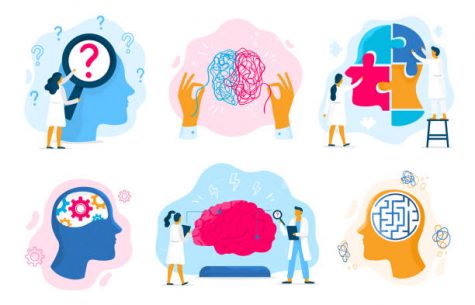Mental Health At Keystone
*This article was substantiated by written responses from Upper School Students answering the following questions:
- Do you experience stress? If so, how does Keystone contribute to this stress, and what is something that Keystone could do to decrease its effect?
- What has your experience been with mental health services at KS?
In early February, Keystone Upper School had its annual visit from Freedom from Chemical Dependency representatives. The FCD curriculum, like the Healthy Futures Sex-Ed program, has been a valuable component of the Keystone experience in recent years. I logged onto the Zoom call with our FCD representative expecting to have conversations similar to previous years, touching on substance abuse prevention and drug education. While we briefly discussed the potency of certain drugs and the transition to a college experience, our conversation centered around stress, not addiction and recovery. We chatted with our representative, Mr. Ian Groves, about the pressures of being a student, the alien experience of online school, and the uncertainty of our college years. We emphasized our disdain for these feelings of anxiety and isolation, and Ian assured us that he would open up a conversation when he met with “a group of administrators” later that day. Unfortunately, this assurance provided me and my classmates with little hope for change, and nothing pertaining to our conversation with Ian was ever addressed by administration. While I understand that Keystone talks about mental health with an emphasis that I am sure is lacking at many other high schools, most communication between students and administration seems to lead only to short-term awareness. I am not suggesting that Keystone serve as a replacement for any necessary external emotional support, but Keystone needs to understand that it is a breeding ground for overworked students. One student believes that the origin of this issue lies in unfulfilled promises made by administration and a toxic culture surrounding grades and work ethic.

After snow week, where students lost power, internet access, and water, leading to some moving into hotels, a statement was made stating that “[the administration’s] goal isn’t to rush to make up this missing week and squeeze it all in during these two weeks before Spring Break.” Despite this assurance and its good intentions, we knew what to expect: a test in almost every class the week before the break, major projects, and essays due with limited extensions. Thankfully, when a scheduling conflict arose and teachers were considering testing on a stress-relief Friday Fun Day, they decided to alter their schedule instead. I would like to be clear that we appreciate our teachers’ flexibility and understanding in these two weeks, and rather our issue lies with the discrepancy between the previous statement and the reality of the Keystone workload. The referenced student argued that statements like these cause Keystone to lose credibility, which is “fundamental in the relationship between students and administration.”
Keystone advertises its students as ambitious, dedicated, and eager to learn, using its students’ reputation and accomplishments to promote the institution. But when student issues surrounding workload are raised, faculty and administration conveniently forget these aforementioned attributes of Keystone students, claiming that our stress is self-induced through the practice of poor time management. This lack of trust in the student body is detrimental to our culture. While it is a given that students will procrastinate a little, we get our work done, study hard, and want to learn. Keystone needs to trust that their students value their education, that they are not trying to cut corners or take advantage when they ask for help. Having a large number of smart and devoted students struggling with mental health issues and stress is extremely concerning.
Instead of only asking “How can we relieve some of the stress students are feeling?”, Keystone should also focus on “How can we decrease what is causing students to experience excessive levels of stress?”. My fellow seniors and I often have conversations about burnout. We think that the core of this issue comes from an unnecessary barrage of work, one that is not beneficial to our learning. While Keystone boasts an accelerated curriculum, which is true, we believe its prestige comes “rigor by volume.” We work harder and study longer than many of our friends from other schools, even if we may be in the same class. If Keystone lightened the workload and encouraged teachers to provide ample time for studying, students would perform better and engage with their education. I understand every single student has a unique learning style, but the most celebrated classes at Keystone, the ones I hear talked about appreciatively in hallways and group chats, are always the ones with the least amount of “busy” work, or work that does not serve students through making them actively apply their learning to solve problems assigned outside of class. An excessive workload also leads to inflated screen time for online students. Most students are on their computers from 8:30 am to 3:45 pm, and one student says they feel guilty taking breaks from their work outside of this time. What’s more is that free periods, time before school, and time after school are potentially spent online in club zoom meetings, studying for upcoming assessments, and completing homework. Another student suggests more asynchronous days to remedy this. Many students also enjoy spending their free time online, and rightfully so, whether that be gaming or watching YouTube or talking with their friends. Social media and platforms like Discord and Facetime are some of the only ways for online students to talk to their friends. Without these platforms, many students could go long periods of time only in communication with their teachers and classmates over Zoom. This level of screen time is unhealthy. And the solution is not to tell students how to spend their free time by instructing them to “Get outside.” It is to give them more free time. Why are we attempting to continue with the normal Keystone experience? It is not the time to make small alterations to simply convert to online learning. It is a time to try out completely new ideas to benefit faculty and the student body.
 A simple solution to frequent conflicts and overloaded students is to maintain the testing calendar strictly. The testing calendar will enable three enhancements to academic organization: a student agenda, scheduling for faculty, and cooperation of testing policy. Students can view all the exams for the week, which is beneficial for rescheduled, retake, or short-notice exams. A calendar will give faculty perspective of a student’s workload and ensure that each day has no more than two exams. Instead of indirectly asking students casually whether there’s an exam on a particular day, teachers should collaborate on what days work best. Being a messenger between two teachers is not a student responsibility. It’s a bunch of he-said-she-said scheduling. If a student can organize quizzes, assignments, exams, projects, and dates among each other– so can faculty regarding exams. The establishment of a quiz calendar is another suggestion that has been raised in recent years. While we realize quizzes often have variable weightings and significance depending on the class, most quizzes demand studying in addition to class time, and they should be considered when a teacher attempts to weigh their students’ workload.
A simple solution to frequent conflicts and overloaded students is to maintain the testing calendar strictly. The testing calendar will enable three enhancements to academic organization: a student agenda, scheduling for faculty, and cooperation of testing policy. Students can view all the exams for the week, which is beneficial for rescheduled, retake, or short-notice exams. A calendar will give faculty perspective of a student’s workload and ensure that each day has no more than two exams. Instead of indirectly asking students casually whether there’s an exam on a particular day, teachers should collaborate on what days work best. Being a messenger between two teachers is not a student responsibility. It’s a bunch of he-said-she-said scheduling. If a student can organize quizzes, assignments, exams, projects, and dates among each other– so can faculty regarding exams. The establishment of a quiz calendar is another suggestion that has been raised in recent years. While we realize quizzes often have variable weightings and significance depending on the class, most quizzes demand studying in addition to class time, and they should be considered when a teacher attempts to weigh their students’ workload.
Keystone community activities and stress-relievers have been planned by the student body, for the student body for the majority of the year. The creation of an optional wellness class, similar to the ninth grade curriculum, that includes all levels of high school could encourage multi-grade level bonding, contact with faculty, and self-care activities. These could occur once a week or a couple of times a month, entwined with or replacing advisory circles or CASAs, and could involve teachers sharing their own passions, like “Dr. Armentrout’s yoga class” or “Mr. C’s movie night.”
When it comes to resources for student mental health, the opportunities are limited. For a few years, Keystone has provided a psychologist and psychiatrist on campus. Dr. Shapiro and Mrs. Raymer were the front and center of assisting students on a flexible schedule. For example, students during off periods would enter Mrs. Raymer’s office if she didn’t have any meetings. She and the student would sit comfortably on the coach and discuss any issues prevalent in the student’s life. From personal experience, she handed me a self-care handbook with daily activities I would complete, and I felt so welcomed and comfortable in her office. However, Mrs. Raymer’s retirement has heightened the demand for mental health professionals for the student body and advocates in faculty meetings. In addition, Zoom learning has worsened student health and suspended Keystone’s program. Assistance is inaccessible for students with technological issues, “Zoom Fatigue,” or anxiety. Administration should adopt a more sympathetic framework when passing policy, renew Mrs. Raymer’s impact, and redefine their definition of “resources.”
What do I mean by a “sympathetic framework”? Currently, Keystone has mainly two services for students to discuss with administration in an official and professional manner. There are check-ins and student council. Check-ins are during CASA periods where the faculty of required classes meet with the grade to discuss academic policy and class imperfections to put forward with administration. Student Council hosts meetings with Mr. Spedding to address club and class issues. As a member of Student Council and a consistent participant in Check-ins, I’ve seen little change on the administrative level to consider student health. When StuCo representatives frantically stress the difficulty of a course’s practices each meeting, the administration needs to view the situation sympathetically and with intent to change. In 2018, I remember entering a Student Council meeting hearing the desperate criticisms and pleas to reform the physics course. Physics students talked to the teacher with no avail, so according to the school’s system, students, who are unable to solve a concern with a teacher, should direct their concerns to administration. And when they brought their concerns to the administration, the administration said that class concerns should be solved between the student and teacher. Sitting in the Student Council meeting, I felt a wave of hopelessness flooding over me–a feeling of pessimism and neglect. I spoke little during those meetings because nothing would change, and nobody intended to change. I felt as if the administration didn’t care that students would sleep four hours each night to study, neglect hygiene and self-care for a passing grade, or most importantly, direct stress unhealthily through suicidal ideation, self-harm, or substance abuse. It happens, and it’s vital to reform the administration’s framework before irreversible consequences.
 Administration should also take initiative to restore Mrs. Raymer’s position with a new faculty member. Since her retirement, the entire Keystone mental health program rests on Dr. Shapiro’s shoulders. Therapy, advocacy, Wellness Council, and program invention relies solely on an individual. This is unfair to both Dr. Shapiro and the student body she serves. Mrs. Raymer was also a pedestal for students. Culturally, my family stigmatized mental health. Words such as “anxiety disorder” or “depression” were forbidden words, and therapy was inaccessible to me. Many students and I relied on Mrs. Raymer for years. The community isn’t spotlighted, but it exists. It’s crucial to nurture the program and sustain its impact on dependent students.
Administration should also take initiative to restore Mrs. Raymer’s position with a new faculty member. Since her retirement, the entire Keystone mental health program rests on Dr. Shapiro’s shoulders. Therapy, advocacy, Wellness Council, and program invention relies solely on an individual. This is unfair to both Dr. Shapiro and the student body she serves. Mrs. Raymer was also a pedestal for students. Culturally, my family stigmatized mental health. Words such as “anxiety disorder” or “depression” were forbidden words, and therapy was inaccessible to me. Many students and I relied on Mrs. Raymer for years. The community isn’t spotlighted, but it exists. It’s crucial to nurture the program and sustain its impact on dependent students.
Lastly, Keystone should redefine “resources.” Resources aren’t empty programs to advertise, and it isn’t just bare-minimum therapy. Sleeping enough, eating well, keeping personal hygiene, loving oneself, and coping properly are resources too. Neglecting healthy outlets has severe consequences. Sleep deprivation causes memory issues, mood changes, weakened immunity, lowered concentration, accidents, and high blood pressure. Poor nutrition intensifies stress, tiredness, capacity to work, and obesity. Without mechanisms to allow students to self care, students direct their stress to unhealthy habits– cutting, hair pulling, drinking, skin picking, and much more. Therapy doesn’t work for everyone, and it’s important to prioritize these resources. Self-harm at Keystone happens, and abandoning those considerations only worsens the conditions for devastating situations.
Mental health is a devastating issue at Keystone, more pressing than substance abuse exponentially. I urge Keystone to re-evaluate its priorities, policy decisions, and student-to-school relationship to alleviate its growing mental health crisis. It’s never too late, and I’m hopeful that Keystone is capable of change. With its passionate and caring faculty, dedication to improve student life, and genuine endeavour to expose students to sexual and substance abuse education, Keystone undoubtedly has the ability and responsibility to grow.

Ella Best is a senior who is passionate about Keystone culture and student life. She serves as the Student Council President and the co-Editor-in-Chief...

Ali Wu, a senior, is excited to represent art in the Keynote with Siona this year! She aims to connect the Keystone community through writing and comics!...


Mr. C • Mar 25, 2021 at 9:57 am
This is a wonderful article. The issues you raise are so important for us to wrestle with as a community. Thank you for your bravery, thoughtfulness, and outstanding recommendations. I vow to do my part to ease the burden students feel and will continue to provide a safe space for each of you to express yourselves.
Michele Giddens • Mar 8, 2021 at 11:14 am
Two amazingly bright, passionate young women working to see change for themselves and, more importantly, those to come. I commend these young women for focusing their words on invoking positive change; the love they have for their school shines through this article. We can critique things we love and push for excellence where there is greatness. It is a sign of true caring to take the time to offer thoughtful criticism followed by reasoned suggestion. There is no doubt in my mind we will see these passionate young women continue in leadership positions for years to come. Way to be the voice girls.
Sarah Gonzales • Mar 5, 2021 at 1:10 pm
Thank you Ella and Ali for writing such an incredible article! Your writing achieves a striking balance between honesty and respect, one that is difficult to accomplish. Through this article, you both have given a voice to the issues faced by anyone who has ever spent a day at Keystone. I applaud you both for speaking up! On behalf of all past, current, and future Keystone students, THANK YOU!